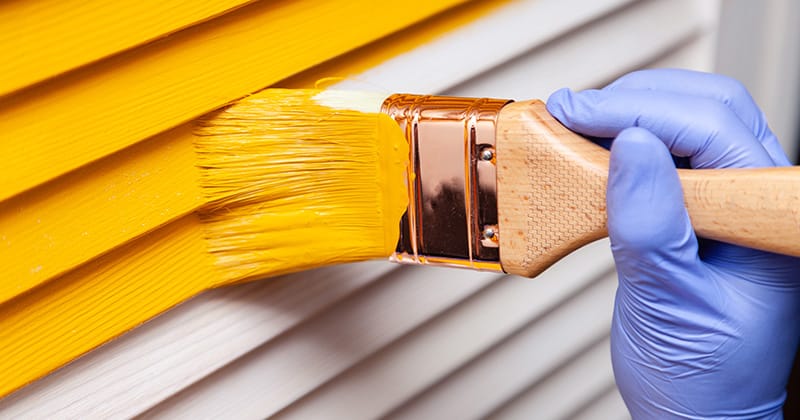How to Start a Painting Company in 9 Steps
If you’ve been thinking about starting a painting business, now is a great time to do it. In this article, we’ll go over 9 steps for how to start a painting company and get it off the ground.

Guest Contributor
Home development has been a hot commodity in the U.S. for a long time.
During the pandemic, DIY projects and home improvements were so popular that supplies ran out. Finding help was nearly impossible, as every contractor was fully booked.
The demand for contractors has not slowed since the pandemic boom. That’s why if you’ve been thinking about starting a painting business, now is a great time to do it.
Starting a painting company is a smart way to break into the home development industry. The overhead is relatively low, it’s easy to get up and running, and homeowners will pay a lot for specialized painting services.
In this article, we’ll go over some straightforward steps for how to start a painting company and get your new business off the ground.
A Look at Painting Company Earning Potential
Starting a painting business can be very profitable. Depending on where you live, there’s a lot of money to be made.
The average contractor in the painting industry makes $94,001 a year. On the lower end, you might make around $53,000 per year. On the higher end, you could make over $155,000 annually.
The high salary potential of a painting contractor is partially due to market expansion. In 2022 alone, the house painting market brought in over $18.6 billion.
Other financial advantages of the painting industry include the high rates of employment and steady income. Not to mention the potential financial advantages of owning your own business.
Startup costs for painting companies are generally low, which means that you likely won’t need a huge loan to get going. If you’re interested in starting from scratch, you’ll be happy to hear that there aren’t complicated or costly certifications either.
9 Steps for Starting a Painting Company
The financial aspects of starting a painting business may sound appealing, but that doesn’t mean there isn’t plenty of work to be done to get started.
To make things easier for you, we’ve narrowed down the top 9 steps for how to start a painting company.
1. Create Your New Business Plan

First things first, when you start a new business, you need to have a plan.
The best place to start with your plan is to decide exactly what services your painting business will offer.
Evaluating the market in your area will help you determine which services will be most profitable. It’ll also help you identify your target audience.
What does the market look like in your area?
Knowing what the market is in your area can help you dial in the rest of your business plan.
Do you have a lot of competitors? What do they specialize in? Armed with information like this, you can better develop a strategy for your painting company.
What’s your specialization?
Once you’ve figured out what your target market needs, you can choose your specialization.
Do you want to do interior or outdoor painting jobs? Do you specialize in certain types of paint or weatherization?
Specializing will help you narrow down your market and get jobs that are more specific to your expertise.
Will you work residential and commercial painting jobs?
There are benefits to working both residential and commercial jobs.
Residential jobs focus on smaller projects within homes, such as the interior painting of a new bathroom. These jobs are usually easier to take on as an individual or new business.
A commercial painting job will focus on bigger projects, such as exterior painting for a new restaurant. This could mean more income, but it also may require a bigger crew and more expensive equipment.
2. Figure Out the Finances for Your New Business
Next up, it’s time to figure out your finances.
While this may not be as fun, it’s essential to starting and running a successful painting company. Getting your finances in order will help you get a realistic idea of what it’s going to take to get started.
Consider a Business Loan
Whether you need money to cover startup costs or just want to keep your savings protected, a business loan could be a good option for you.
Small business loans are usually very simple to apply for. Fortunately, most banks have easy systems in place to help you navigate this process.
A small business loan can cover anything from your business license to your equipment and even payroll.
It’s crucial to know exactly what your initial financial needs are. This will help you make sure the bases are covered.
Starting a business without organized finances can cause a lot of problems later on. So, it’s best to be on top of this from the starting line.
3. Choose a Name and Register Your Painting Business
Now that you have a plan, it’s time to officially register your business. There are a few different types of businesses you can register as.
The business type you choose will affect your taxes and insurance options. Insurance, especially in the home development industry, is essential. You don’t want to have any hiccups down the road.
Choose Your Business Name
Naming your business doesn’t have to be complicated. The key is to keep it simple and memorable.
For example, you could name your business after yourself, something like “Smith’s Painting Company.” This is simple and relatable. Or you could choose a name that reflects the services you provide, such as “The Commercial Painting Crew.”
Don’t overthink it, just go with something that rolls off the tongue and will stick in your clients’ minds.
Get Your Business License and Registration in Order
As we mentioned, there are a few different categories in which you can register your business. Here are the three primary types of business licenses to choose from:
- Sole Proprietorship: This license will directly tie the owner to the business. It’s easy and inexpensive to set up. However, you’ll be personally liable for anything to do with the business.
- Corporation: A corporation is a great option for larger companies. This business type removes the business owner from the business entity. But it does require more regulations and finances.
- Limited Liability Company (LLC): An LLC is the most common business type for small companies. It protects the owner from any liability related to the business. They’re also easy and affordable to establish.
Insure Your Company
Insurance for your painting company will protect you, your equipment, and any employees in unexpected situations. Whether there’s a lawsuit or an injury, it’s smart to stay covered.
The most common type of insurance that you’ll need is called general liability insurance. It’ll cover you against lawsuits for any financial, property, or bodily damage related to a job or your business.
The cost of general liability insurance varies depending on your business size and type. On average, though, it’ll cost you about $50 a month.
4. Get Painting Equipment

As a painting contractor, you’re going to need the right painting equipment before you can start any jobs.
When purchasing painting equipment, consider what your niche is. Is there anything specific to this that you’ll need beyond standard supplies? For example, residential and commercial paint jobs require different equipment.
Also consider if there’s any technology available that might help simplify your business, such as invoicing software.
Here are some of the basic painting tools you’ll need to get started:
- Tape measure
- Painter’s tape
- Paint roller
- Paint sprayer
- Painters multi-tool
- Brushes
- Wall filler
5. Learn How to Give an Estimate for Painting Jobs

A big part of running a successful business is knowing how to give potential clients an estimate.
Evaluating a project successfully means that you’ll be giving your client an accurate and fair price—without undercutting yourself on any work.
Knowing your skill level and the project scope will help you make more accurate estimates. And accurate estimates will keep your customers happy.
Here are a few other tips to keep in mind when it comes to painting job estimates:
Consider the Cost of Your Materials
How much paint and other materials a job will require will depend on the type of job. If the job is interior, for instance, it will likely require more paint.
Another factor to consider when evaluating material cost is the square footage of a project will take. Things like ceiling height, cabinet measurements, and window coverage all factor into this as well.
Develop a Strategy for Pricing
There are a few different ways you can price your paint jobs. One common strategy is to charge per square foot. Another strategy is to multiply the paint costs, or to charge hourly plus materials.
Just make sure you’re consistent with your pricing strategy, so that your referrals will be accurate.
Calculate Your Labor Costs
Each job’s labor costs will be determined by the size of your crew and the scope of the project. You’ll need to factor in how many employees will be on the job, their hourly rates, and any other individual employee-related costs.
Also, you’ll need to consider the requirements of the project. If a house is new, for example, priming and more layers of paint will be required. This will amount to more labor time.
Don’t Underestimate Your Worth
Your skills and time are valuable. Bottom line.
6. Market Your Painting Company
Marketing is crucial to expanding your business.
Marketing your painting company includes a wide range of efforts to get the word out about your services and reputation. Anything from a functioning website to email marketing campaigns and beyond can bring in new projects and help to expand your clientele.
Let’s look at a few simple places you can start for marketing your painting business.
Build a Website
Build out a smooth and comprehensive website. Include photos of previous projects, and some customer reviews to verify your skills.
Your website should be simple and straightforward. Make sure all the information is current and easy to read. A contact form will also make requesting quotes or appointments simple.
Squarespace, Weebly, and GoDaddy are all excellent platforms to start building your website for free.
Start Email Marketing
Email marketing is an effective way to build clientele and keep old clients up to date on services. It allows you to keep all your contacts compiled into one list.
Your email campaigns can be as simple as a monthly newsletter with any updates on projects, prices, or new painting services in your business.
Consider Hiring a Freelancer
If you feel like marketing may be out of your skill scope, or you simply don’t have time for it, don’t worry! There are many options for help.
If business is booming and you just can’t seem to stay on top of marketing, you may want to hire an employee to help. Or, if you’re just wanting to get going and only have a few projects here and there, you might consider hiring a freelancer.
Freelance marketers range from social media specialists to email marketers, copywriters, and so on. There are many talented individuals out there who would happily help develop your marketing strategy.
Sites like Upwork and Fiverr have smooth and easy hiring platforms for freelancers.
7. Build a Community—Word-of-Mouth Reviews Are Everything

Any home development work is dependent on good reviews. This means that building a loyal community of customers is essential to developing your clientele.
Word-of-mouth reviews are often how painting contractors get referred for new jobs. Focusing on great client relationships and building connections will give you a good reputation within the industry. This means business connections and more opportunities.
Stay in Touch With Clients
Circling back with clients to ensure they’re in love with their new paint job is important. This shows that you’re interested in doing a job right and doing it well.
Making ongoing communication and customer service the primary focus of your business will reflect on you positively. Clients are much more likely to recommend you if you’ve built a personal connection.
Build Community Within the Industry
Building good relationships within the painting industry can help you get referrals and maybe even deals on supplies. This means establishing positive relationships with your suppliers.
Making connections with anyone from your local insurance agent to your Home Depot employee could mean new referrals to your painting business.
If you’re wanting to stay connected to the industry, there are various organizations that you can join. The National Association of Home Builders is a great option if you’re interested in networking with other home service companies
8. Hire Employees
Once your painting business is established, you may want to consider hiring some help.
Whether you’re just taking on bigger projects or even multiple all at once, having someone to assist you will make your business run much smoother.
This could be anyone from an office assistant to a subcontractor every now and then or a full team of painters.
Determine if You Need a Full-Time Employee, Part-Time Employee, or Subcontractor
When thinking about hiring help for your painting business, you must evaluate your long-term needs.
Is your business bringing in large projects consistently? Do you have too many projects to juggle? Do you need help with a one-time large project?
Knowing what your needs are will help you determine what type of help you need. If your need for help is consistent, you’ll probably want one or multiple full-time or part-time employees.
If your need for help is more temporary or on a job-to-job basis, a subcontractor might be a better fit. A subcontractor is an individual with a specific skillset that can help you get the job done.
Sub-contractors operate under their own employment and tax system. This means that they will invoice you for their services.
Figure Out Payroll
Hiring employees at your painting company will mean dealing with payroll. Employees will need to file a W-2, and you’ll need to establish a payroll schedule.
As the business owner, you’ll also need to determine what kind of retirement/health care plans you’ll provide (if any). This will determine what finances are withheld from the employee and what the employer is expected to contribute.
9. Let Your Painting Services Speak for Themselves
This one should be obvious, but it is important to remember. Your company is run by you, which means that any mistakes are yours to handle.
The key to success is to let the quality of your services speak for your business—which means you must prioritize excellence during every job.
Starting Your Painting Company: What’s Next
These 9 steps will help you establish your painting business and get it off the ground. It’ll take time to work through them all, but when the jobs start coming in, you’ll be glad you did.
If you’re eager to get started building your company right away, here are a few easy things you can do right now:
- Decide on a business type. Before you can make your painting company official, you must know what type of license you need. Review the pros and cons of the business types we went over. Then, evaluate which type of business structure will best fit your needs and goals.
- Brainstorm business names. Make your new business venture feel more real by coming up with a name for it. Write out any ideas you have, adjectives you like, and things like your name or local area. Try using a free business name generator to put them together and create the perfect name.
- Make a list of essential equipment. Identifying the essential tools you’ll need to complete jobs can help give you a starting point for your budget and pricing strategy.
- Create a free website. Choose a platform to create your painting company’s website. You can use one of our above recommendations or research other website builders to see what you like. Then, simply create an account and start building.
Selah is a freelance journalist. Her professional passions include psychology, sociology, and regenerative education. When she's not writing, you can find Selah traveling the world, cooking without a recipe, or catching an early morning surf.

Business Solutions For Field Service Pros
EverPro offers specialized solutions designed for home and field service professionals. We’ve got the business tools to help you get the job done.



